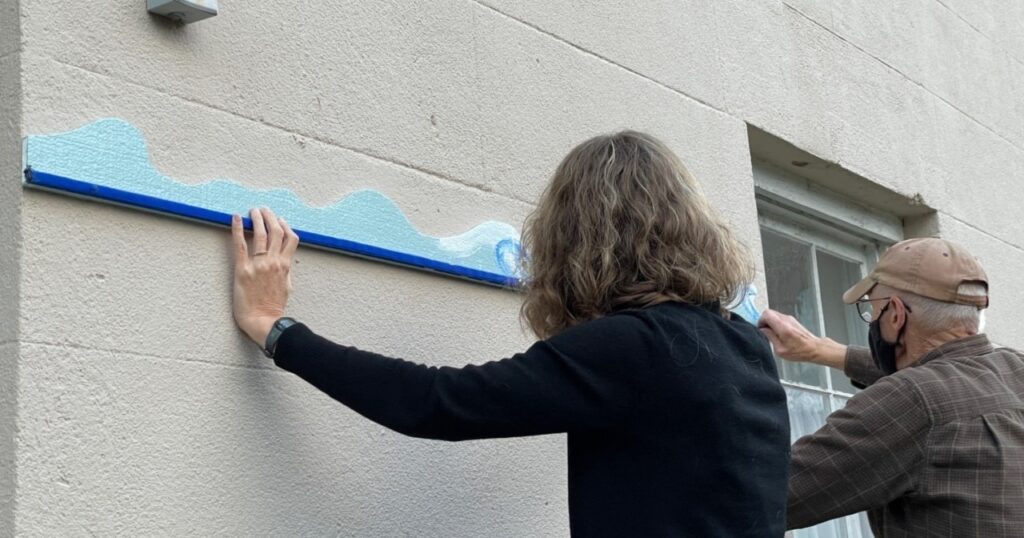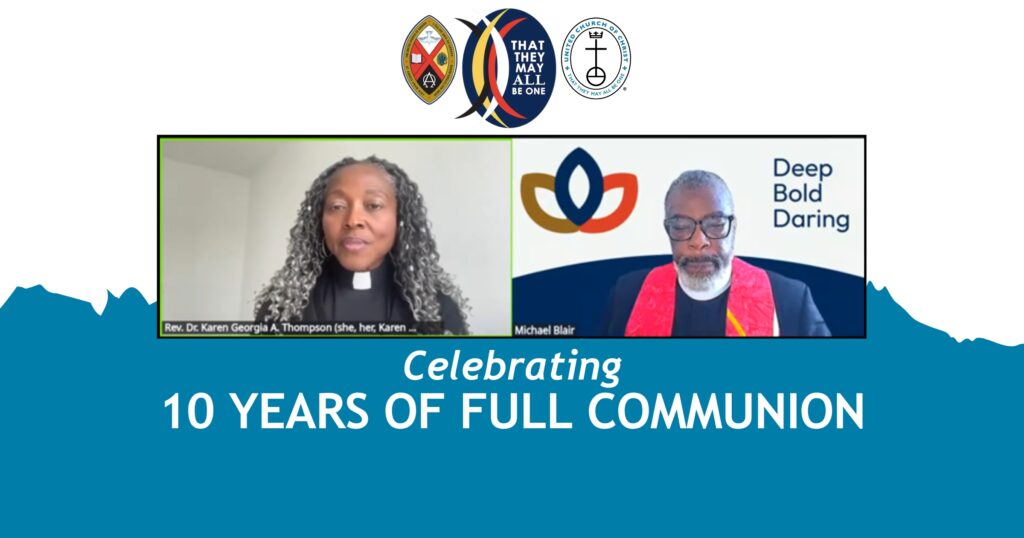Charleston church’s Blue Line Project charts sea level rise, bears witness to climate change
Circular Congregational Church in Charleston, S.C., has embraced a project that illustrates the coming reality that is climate change. The United Church of Christ congregation is marking rising sea levels on a low-lying peninsula in a tangible way and inviting public interaction about the issue.
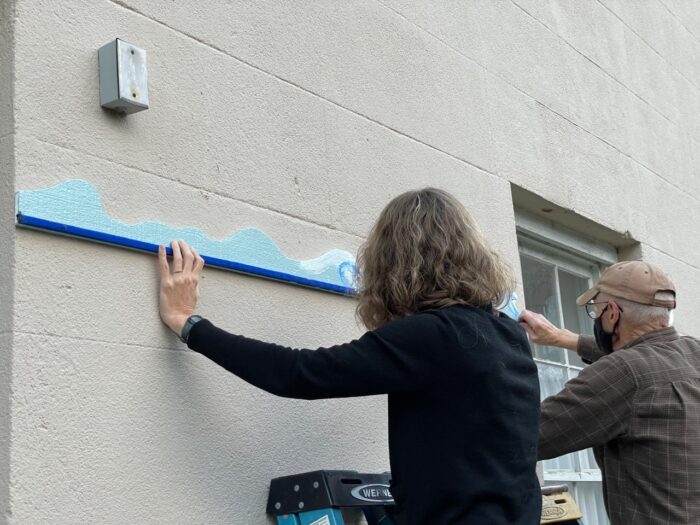
“We’re putting up a blue line to bear witness to climate change,” said Circular’s senior pastor, the Rev. Jeremy Rutledge. “It’s a dramatic attempt to draw attention to the crisis here at sea level.”
The historic downtown church, founded in 1681, dates back to colonial Charleston. Church members decided to use its prominent location to note the tangible threat of rising seas and appeal to the hundreds of tourists who walk through their campus every day with an easy way they can learn more.
The congregation has installed wavy blue lines on its buildings, marking the waterline at storm surge, so one could see what would be underwater. They also installed signs around the church yard that tell the story behind their Blue Line Project.
Immediate threat
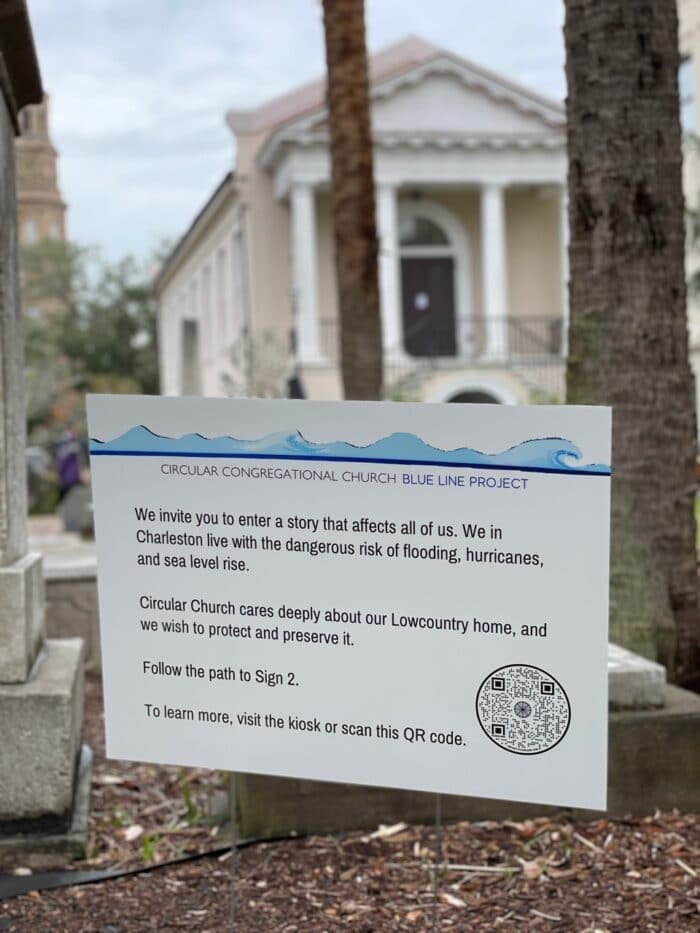
“The main things we tried to communicate, we wanted to spell out in the text,” Rutledge said. “We wanted to use it to bear witness to the reality of climate change in the place where we live. We wanted to invite visitors to pause and consider where they were standing and how it was threatened. We wanted to name who is most affected by the climate crisis; not us, but our lower-lying neighbors. And we wanted to ask people to join us in responding to the crisis here in the Lowcountry or in the place where they live.”
The pastor said the threat is “immediate.” Circular Church sits 10 feet above sea level, but much of the community lives at sea level. The city floods regularly. In a column he wrote earlier this year, Rutledge laid out the issue.
“In 1950, Charleston experienced tidal flooding twice. Last year, it happened more than 40 times. By 2051, models predict we can expect 60 days of tidal flooding. Also since 1950, our sea level has risen 11 inches. As the water warms and rises, it makes for more frequent and intense hurricanes. In 2020, we saw 30 named storms, 13 of which became hurricanes.”
Today, 2050 and 2100
Circular Church decided to use Hurricane Hugo, which came ashore north of Charleston in 1989, as the benchmark. The blue lines mounted on the building walls mark the height of a storm surge if a hurricane equivalent to Hugo were to make landfall in Charleston today, in 2050, and in 2100.
Members of the Blue Line Project team – an oceanographer, an engineer and a teacher, along with a group of young people – spent several weeks calculating where to install the blue lines. They started with a geographical survey downtown on Sept. 19.
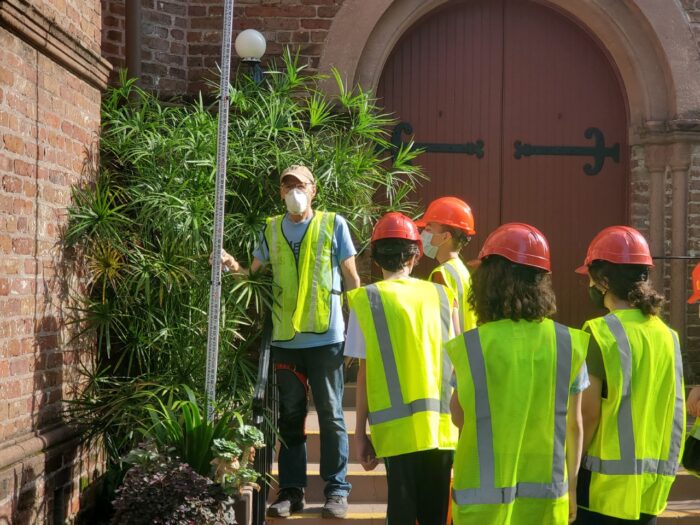
Dr. Stephen Cofer-Shabica, coastal scientist and church sexton, said the team of three adults and six youth used the data collected to place the blue lines at the predicted sea level elevation with a storm surge of 15 feet. The group planned that installation for Nov. 7. But ironically, before they could get them up, high water – in the form of a king tide – intervened.
“The same weekend that we planned to install the blue lines, Charleston experienced one of its top 10 highest tidal flooding events,” said Sara Rutledge. The pastor’s wife, a high school science teacher, said, “It was not lost on church members that the same weekend we had to cancel a Saturday event due to flooding we highlighted how sea level rise will affect Charleston.
“I don’t think that most people know how much sea level rise is predicted to increase over the next 30 years and 80 years. It is breathtaking to see those numbers depicted on the wall.”
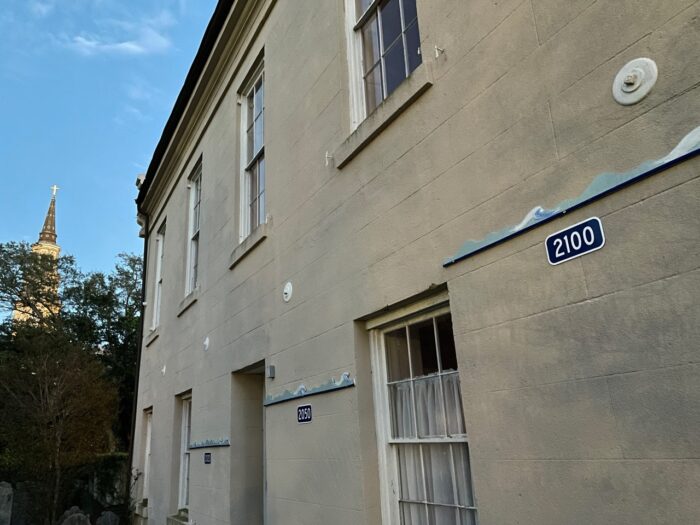
‘It is going to worsen’
Numbers, team members say, only underscore what people are living with right now.
“Hurricane Hugo was incredibly damaging, but it missed Charleston,” Jeremy Rutledge said. “It could have been a whole lot worse with a direct hit. It’s easily within the realm of possibility – more when, not if. It’s only a matter of time. People remember that viscerally. Many people have lost their homes. They had to call off church services, batten down and leave town. Everyone has observed the increase of storms and the increased strength of storms.”
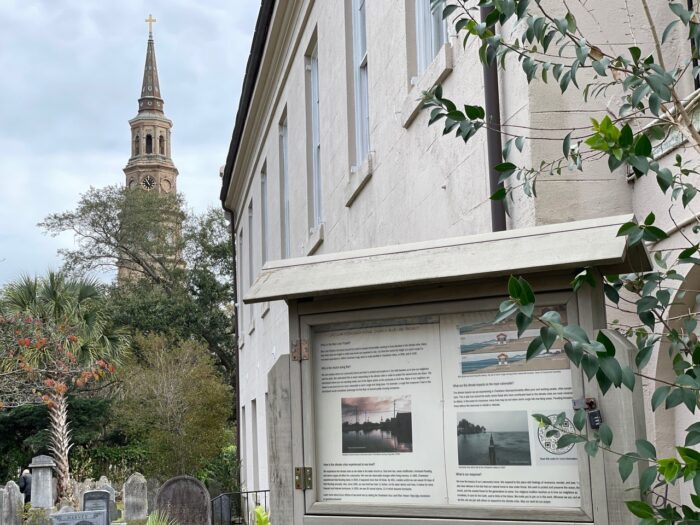
“While in graduate school back in the 70’s, we researched and predicted, based on measured melting of Arctic and Antarctic sea and continental ice, where sea level would be in 2070. Turns out, we were 50 years off,” Cofer-Shabica said. “The 2070 rates of sea level rise, and accelerated glacial melt are here, today in 2021.
“I am hopeful that the exhibit will make the short- and long-term impacts of sea level rise on Charleston more proximate; not something that future generations will need to address,” he continued. “It is going to worsen even if we adopt stringent greenhouse gas controls. I believe the students understand this, and recognize that their generation will be greatly impacted sooner than later.”
‘A call to action’
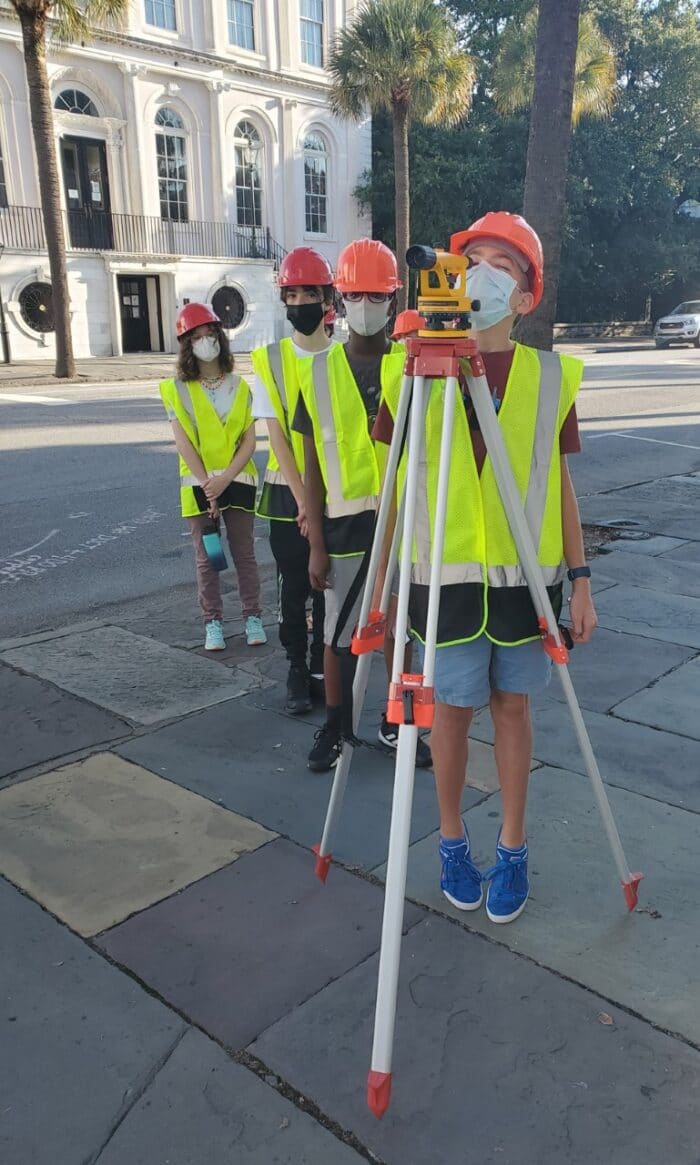
Eli Barker is one of six young people involved in the project. He and the others spent a lot of time on the survey work in downtown Charleston and on the Circular campus.
“I care about the future of our church and the legacy I leave behind at Circular,” Barker said. “It means a lot that I have a church that is willing to care about the future of our environment and so I am always happy to help.
“It is important that I work to educate myself and others on the current climate crisis in hopes that we can better protect our church and Charleston as a whole. I hope that others see our work and feel a call to action.”
Inviting a response
On Nov. 10, the crew finished mounting the markers that show where rising waters could surge to. They also posted signs around the church campus, leading people through the exhibit, telling the story of the blue lines.
“We invite people who walk through the installation to stand in front of the wall where the blue lines are mounted,” Sara Rutledge said. “When they get up close to the wall, we hope they will notice that even today, a strong hurricane would bring water to shoulder height in our church yard, which is on a high spot on the peninsula. We want people to walk away knowing that many people’s homes are lower than our churchyard and would be completely inundated, and that the problem is going to get worse over time. We also hope they will look at the links we provide to learn what they can do to take action on climate change.”
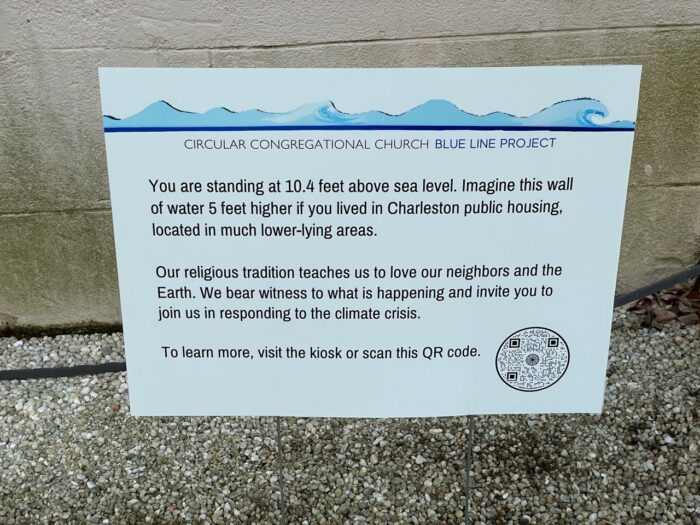
The signs spell out the rising threat and offer webpage links to provide more information. With a QR code tracker, the church can discern how many people are accessing the content.
“Our church has long been committed to caring for the Earth,” Jeremy Rutledge said. “Yet this does feel like a moment of crisis, a moment to bear witness, a moment to use our platform, our voice, and our energy to care for the Earth. It is sacred to us.”
Related News
A Moment of Silence
The weekend news was alarming. Two students shot and killed with 9 injured at Brown University...
Read MoreIn hope-filled worship service, UCC and United Church of Canada celebrate full communion past and future
On Saturday, Dec. 13, many from the United Church of Christ (UCC) and the United Church of...
Read More‘A Gift of God to the World:’ Christmas greetings from the General Minister and President
As Christmas quickly approaches, UCC General Minister and President/CEO the Rev. Karen Georgia...
Read More